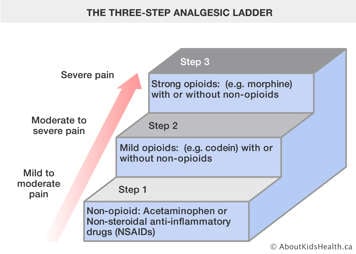JIA medications to reduce inflammation can also help to reduce JIA pain. In this page, you will learn about other common pain medicines that can help control pain. It is important for you to learn about medications that can help reduce pain. Speak to the doctor about these options and decide together if they are something to try.
JIA medications can help reduce pain and inflammation. JIA medications include:
- non-steroidal anti-inflammatory drugs (NSAIDs) such as ibuprofen
- disease-modifying anti-rheumatic drugs (DMARDs) such as methotrexate
- corticosteroids such as, prednisone, prednisolone, or dexamethasone
- biologic drugs such as etanercept and infliximab. Biologics are sometimes used in children and teenagers who do not respond to the other medications.
Types of pain medicines
Pain medicines are also called analgesics or painkillers. There are three main types of pain medicines:
- non-opioids, such as acetaminophen and NSAIDs
- opioids, such as codeine and morphine
- local and topical anaesthetics, such as lidocaine and EMLA
A step-wise approach is commonly used to treat pain.

Mild pain: Simple analgesics
Simple analgesics such as acetaminophen and NSAIDs such as ibuprofen can relieve mild pain. Some mild pain relievers can be taken together if needed. However, ibuprofen should not be taken if the doctor has prescribed another NSAID.
Moderate pain: Mild opioids
For moderate pain, simple analgesics can be used with mild opioid medicines, such as tramadol.
Severe pain: Strong opioids
For more severe pain, simple analgesics may be used with stronger opioid drugs, such as morphine.
These stronger pain medications are normally used for pain after surgery. They are also used for some chronic pain conditions that do not respond to standard medical treatment. Strong opioid medications are not commonly used to treat JIA pain.
Like most medicines, opioids have side effects. These include slowing breathing, sleepiness, nausea, vomiting, constipation, and itchiness. It is important to discuss the benefits and side effects of any drug with the doctor.
Local and topical anaesthetics
Local anaesthetics act on a specific part of the body. Lidocaine is a local anaesthetic that is given by injection. Some local anaesthetics are applied on the skin, in which case they are called topical anaesthetics. Examples of topical anaesthetics include EMLA cream and tetracaine. These anaesthetics help to numb the surface of the skin. They can help reduce pain from needle pokes and other procedures.
Other pain medications
There are also some other medications that are used with special types of chronic nerve pain. These include tricyclic antidepressants such as amitriptyline, and anticonvulsants such as gabapentin . These medications help to calm the pain nerves down.
How to take pain medicines
There is a right way and a wrong way to take medicine. The most common mistake people make when taking painkillers is not taking them soon enough. Most people wait until their pain is really bad before taking pain medicine. It is much easier to prevent pain from becoming unmanageable if the medicine is taken early (when pain is mild) and regularly.
Medicine should always be taken according to the directions on the bottle or the way the doctor has indicated. Too much medicine can cause serious harm. But, if a child takes less than the recommended dose, the medicine may not work.
Pain medications work best when used with physical and pain coping strategies.